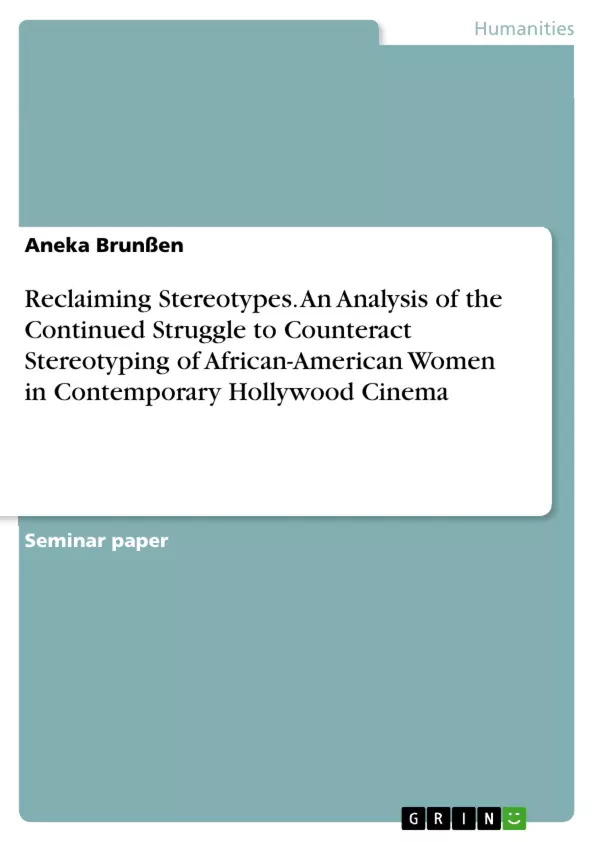This analysis serves to outline the continued struggle of African-American women to counteract racially and sexually biased stereotypes as perpetuated by the popular media domain of Hollywood cinema in a white-dominated, patriarchal society. Moreover, it serves to shed light on recent activism and achievements, which are now commonly referred to as ‘reclaiming stereotypes’.
Resistance from within the industry will be exemplified by juxtaposing the 2009 film “Precious”, an independent production which was majorly successful, with other film productions from the same year, which serve to perpetuate the misrepresentation of African-American women. Furthermore, activism stemming from sources outside of the cinema industry will be detailed, as part of a growing mind state of contempt for stereotyping African-American women.
Inhaltsverzeichnis (Table of Contents)
- Introduction
- Background Information
- History of Stereotyping African-American Women in Hollywood Cinema
- History of Counteracting Stereotypes of African-American Women in Hollywood Cinema
- Analysis
- Stereotyping of African-American Women in Contemporary Hollywood Cinema
- Counteraction against Stereotypical Depictions of African-American Women in Contemporary Hollywood Cinema
- Independent Film vs. Mainstream Hollywood: Precious (2009)
- Other Activism
- Conclusion
Zielsetzung und Themenschwerpunkte (Objectives and Key Themes)
This analysis aims to examine the ongoing struggle of African-American women to challenge racial and sexual biases perpetuated by Hollywood cinema within a white-dominated, patriarchal society. It highlights recent activism and achievements in "reclaiming stereotypes." The analysis also compares the independent film "Precious" (2009) to other films from the same year to illustrate the contrast between independent productions challenging stereotypes and mainstream Hollywood films perpetuating them. Additionally, activism originating outside of the cinema industry will be explored.
- Stereotyping of African-American women in Hollywood cinema
- Historical context of racism and sexism in the film industry
- Activism and resistance against stereotypical representations
- Independent film as a space for challenging dominant narratives
- The role of cultural hegemony in shaping media representations
Zusammenfassung der Kapitel (Chapter Summaries)
The introduction sets the stage by discussing the pervasive nature of stereotyping in Hollywood cinema, particularly concerning African-American women. It highlights the need to understand how these stereotypes are rooted in historical and societal contexts of racism and sexism.
The background information chapter delves into the history of stereotyping African-American women in Hollywood, exploring how these representations have reflected and reinforced broader societal biases. The chapter analyzes how Hollywood has often perpetuated the 'primitive and animalistic' and 'obedient servant' stereotypes, both of which reinforce white supremacy and justify racial oppression.
The analysis section examines how contemporary Hollywood cinema continues to perpetuate stereotypes of African-American women, despite increasing awareness and activism. The chapter then focuses on the independent film "Precious" (2009), highlighting its success in challenging these stereotypical representations. It also explores other forms of activism that have emerged to counteract the harmful effects of stereotyping.
Schlüsselwörter (Keywords)
The main keywords and focus topics of this analysis include: stereotyping, African-American women, Hollywood cinema, cultural hegemony, racism, sexism, activism, independent film, "Precious" (2009), representation, counteraction, reclaiming stereotypes.
- Quote paper
- Aneka Brunßen (Author), 2017, Reclaiming Stereotypes. An Analysis of the Continued Struggle to Counteract Stereotyping of African-American Women in Contemporary Hollywood Cinema, Munich, GRIN Verlag, https://www.grin.com/document/364530



